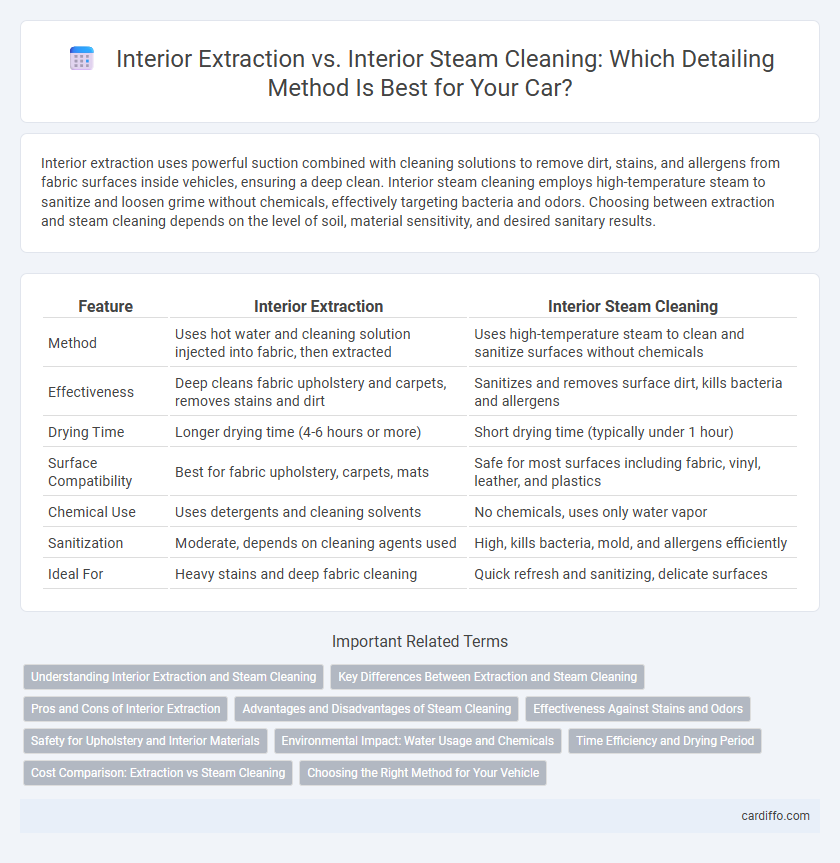Interior extraction uses powerful suction combined with cleaning solutions to remove dirt, stains, and allergens from fabric surfaces inside vehicles, ensuring a deep clean. Interior steam cleaning employs high-temperature steam to sanitize and loosen grime without chemicals, effectively targeting bacteria and odors. Choosing between extraction and steam cleaning depends on the level of soil, material sensitivity, and desired sanitary results.
Table of Comparison
| Feature | Interior Extraction | Interior Steam Cleaning |
|---|---|---|
| Method | Uses hot water and cleaning solution injected into fabric, then extracted | Uses high-temperature steam to clean and sanitize surfaces without chemicals |
| Effectiveness | Deep cleans fabric upholstery and carpets, removes stains and dirt | Sanitizes and removes surface dirt, kills bacteria and allergens |
| Drying Time | Longer drying time (4-6 hours or more) | Short drying time (typically under 1 hour) |
| Surface Compatibility | Best for fabric upholstery, carpets, mats | Safe for most surfaces including fabric, vinyl, leather, and plastics |
| Chemical Use | Uses detergents and cleaning solvents | No chemicals, uses only water vapor |
| Sanitization | Moderate, depends on cleaning agents used | High, kills bacteria, mold, and allergens efficiently |
| Ideal For | Heavy stains and deep fabric cleaning | Quick refresh and sanitizing, delicate surfaces |
Understanding Interior Extraction and Steam Cleaning
Interior extraction uses specialized machines to inject cleaning solutions deep into upholstery and carpets, then simultaneously extracts dirt, allergens, and moisture, offering a thorough cleanse. Interior steam cleaning employs high-temperature steam to sanitize surfaces, break down grime, and kill bacteria without harsh chemicals, ideal for delicate materials. Both methods effectively improve vehicle hygiene and appearance but target different levels of soil and fabric types.
Key Differences Between Extraction and Steam Cleaning
Interior extraction uses powerful suction combined with cleaning solutions to remove deep-seated dirt and stains from upholstery and carpets, effectively minimizing moisture retention. Interior steam cleaning employs high-temperature steam to sanitize surfaces, kill bacteria, and loosen grime without the use of chemicals, promoting faster drying times. Extraction is best for deep cleaning heavy soiling, while steam cleaning excels in disinfecting and refreshing interior surfaces.
Pros and Cons of Interior Extraction
Interior extraction effectively removes deep-seated dirt, stains, and allergens from upholstery and carpets, enhancing vehicle hygiene and appearance. However, it requires longer drying times and may risk mold growth if moisture is not thoroughly eliminated. Compared to steam cleaning, interior extraction is more intensive but demands careful moisture management to prevent damage.
Advantages and Disadvantages of Steam Cleaning
Interior steam cleaning offers deep sanitation by using high-temperature vapor to remove dirt, bacteria, and allergens from fabric surfaces, which extraction methods may miss. This technique is advantageous for its chemical-free nature and ability to penetrate fibers, but it risks moisture damage or mold growth if not properly dried. Extraction, in contrast, provides thorough water removal, reducing drying time but often requires detergents that can leave residues.
Effectiveness Against Stains and Odors
Interior extraction uses powerful suction and cleaning solutions to remove deep-seated stains and trapped odors from upholstery and carpets, providing a thorough clean. Interior steam cleaning employs high-temperature steam to break down surface stains and sanitize the fabric, effectively neutralizing odors without harsh chemicals. Combining both methods can maximize stain removal and odor elimination for a fresher vehicle interior.
Safety for Upholstery and Interior Materials
Interior extraction uses powerful suction and specialized cleaning solutions to safely remove deep dirt and stains from upholstery and interior materials without causing damage. Interior steam cleaning employs high-temperature steam that sanitizes surfaces and kills bacteria, but it must be carefully controlled to prevent heat or moisture damage to sensitive fabrics and materials. Choosing the right method depends on the type of upholstery and the manufacturer's recommendations to ensure maximum safety and preservation of interior components.
Environmental Impact: Water Usage and Chemicals
Interior extraction uses significantly less water than interior steam cleaning, reducing overall water consumption and minimizing wastewater discharge. Steam cleaning generally involves higher chemical usage to achieve deep sanitization, which can introduce environmentally harmful residues into the ecosystem. Choosing interior extraction supports sustainability by conserving water resources and limiting chemical pollutants.
Time Efficiency and Drying Period
Interior extraction uses powerful suction to remove dirt and moisture from car upholstery quickly, significantly reducing drying time compared to interior steam cleaning. Steam cleaning relies on heat and moisture to lift stains, which often results in longer drying periods due to residual dampness. For faster turnaround in detailing services, interior extraction offers greater time efficiency and quicker readiness for use.
Cost Comparison: Extraction vs Steam Cleaning
Interior extraction typically costs between $100 and $250 per vehicle depending on the size and condition, offering deep stain removal with specialized equipment. Interior steam cleaning generally ranges from $80 to $150, providing effective sanitization and odor removal without harsh chemicals. Extraction delivers a more thorough clean suitable for heavy soils, while steam cleaning offers an eco-friendly, cost-efficient option for routine maintenance.
Choosing the Right Method for Your Vehicle
Interior extraction uses powerful suction combined with cleaning solutions to remove deep-seated dirt, making it ideal for heavily soiled fabrics and carpets. Interior steam cleaning employs high-temperature steam to sanitize and lift grime without chemicals, best suited for delicate surfaces and eco-conscious owners. Selecting the right method depends on your vehicle's material, level of dirt, and personal preferences for chemical use and drying time.
Interior Extraction vs Interior Steam Cleaning Infographic

 cardiffo.com
cardiffo.com